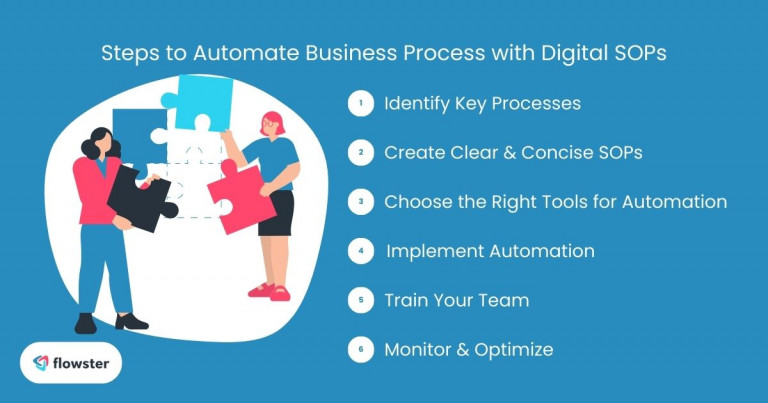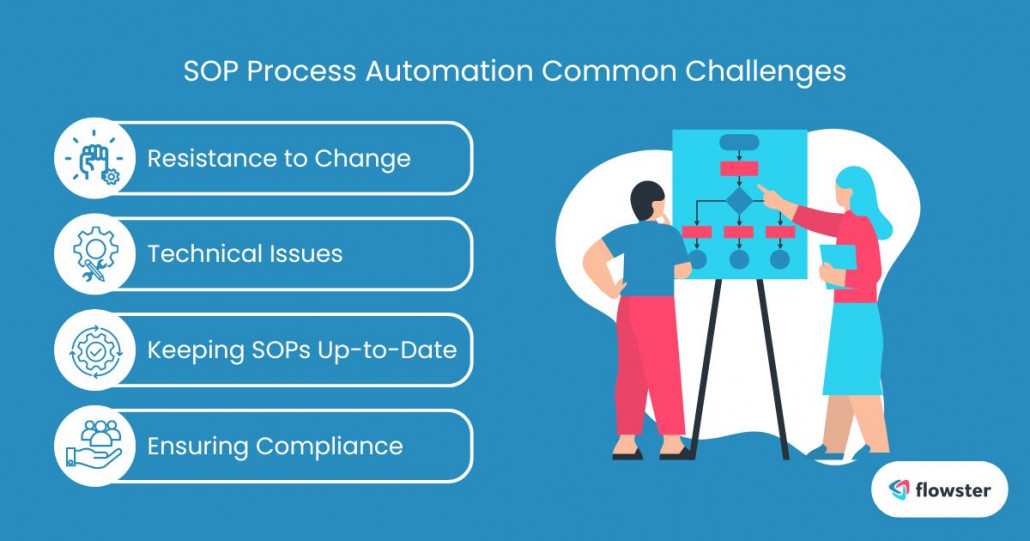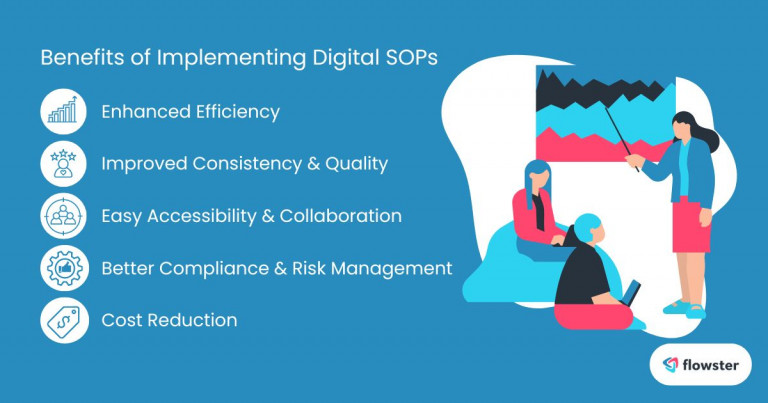In today’s fast-paced business environment, efficiency and consistency are key to success. Standard Operating Procedures (SOPs) have long been recognized as a crucial tool for streamlining operations and ensuring that tasks are performed consistently across an organization. However, as technology continues to advance, the concept of SOPs has evolved, giving rise to digital SOPs. These innovative solutions offer a range of benefits that can significantly enhance your business’s productivity and profitability.
In this article, we will delve into the world of digital SOPs and explore how they can revolutionize your approach to SOP process automation. We will discuss the advantages of implementing digital SOPs, provide a step-by-step guide on automating your business processes, and share real-world examples of successful SOP process automation. By the end of this article, you will have a clear understanding of how digital SOPs can help you optimize your workflows, reduce errors, and drive your business forward in the digital age.
So, let’s dive in and discover how digital SOPs can transform your business through SOP process automation!
Article Outline
What Are Digital SOPs? Understanding the Foundation of SOP Process Automation
In the realm of business operations, Standard Operating Procedures (SOPs) serve as essential guidelines that outline how specific tasks should be performed. As businesses increasingly embrace digital transformation, the concept of SOPs has evolved into what we now refer to as digital SOPs. This section will explore the definition of digital SOPs and their transition from traditional formats, laying the groundwork for understanding how they contribute to SOP process automation.
Definition of SOPs
Standard Operating Procedures (SOPs) are documented processes that provide detailed instructions on how to perform specific tasks within an organization. They are designed to ensure consistency, efficiency, and quality in operations. SOPs can cover a wide range of activities, from routine tasks to complex procedures, and are essential for maintaining operational standards across various departments.
Transition to Digital
The shift from paper-based SOPs to digital formats marks a significant advancement in how organizations manage their processes. Digital SOPs leverage technology to enhance accessibility, collaboration, and ease of use. Unlike traditional SOPs, which may be cumbersome to update and distribute, digital SOPs can be easily modified and shared across the organization in real-time. This transition not only streamlines the creation and dissemination of SOPs but also aligns with the growing trend of SOP process automation, enabling businesses to automate workflows and improve overall efficiency.
As we move forward, it’s essential to understand the numerous benefits that come with implementing digital SOPs. In the next section, we will explore how these advantages can transform your business operations and drive successful SOP process automation.
Benefits of Implementing Digital SOPs: Unlocking Efficiency Through SOP Process Automation
Implementing digital SOPs offers a myriad of advantages that can significantly enhance business operations. By transitioning from traditional paper-based procedures to digital formats, organizations can streamline processes, improve compliance, and foster collaboration. In this section, we will explore the key benefits of digital SOPs and how they contribute to effective SOP process automation.
Enhanced Efficiency
Digital SOPs streamline workflows by providing clear, easy-to-follow instructions that can be accessed anytime, anywhere. This accessibility reduces the time employees spend searching for information or clarifying procedures, allowing them to focus on their core tasks. Furthermore, automated reminders and notifications can ensure that employees adhere to the established processes, further enhancing overall efficiency.
Improved Consistency and Quality
With digital SOPs, businesses can ensure that every employee follows the same standardized procedures. This consistency minimizes the risk of errors and discrepancies, leading to higher-quality outputs. By maintaining uniformity in operations, organizations can enhance their reputation and customer satisfaction, which are critical components of long-term success.
Easy Accessibility and Collaboration
Digital SOPs can be stored in cloud-based systems, making them easily accessible to all team members, regardless of their location. This accessibility facilitates collaboration, as employees can work together in real-time, share feedback, and make updates as necessary. By breaking down silos and promoting teamwork, digital SOPs create a more cohesive work environment.
Better Compliance and Risk Management
In industries where compliance with regulations is paramount, digital SOPs play a crucial role in ensuring adherence to standards. Automated tracking and reporting features help organizations monitor compliance and identify potential risks before they escalate. This proactive approach not only safeguards the business against penalties but also fosters a culture of accountability.
Cost Reduction
By reducing errors, improving efficiency, and enhancing compliance, digital SOPs can lead to significant cost savings for organizations. The automation of repetitive tasks minimizes labor costs and frees up resources for more strategic initiatives. Ultimately, this financial efficiency allows businesses to allocate their budgets more effectively and invest in growth opportunities.
In summary, the benefits of implementing digital SOPs are profound and far-reaching, particularly when it comes to SOP process automation. As we continue, we will explore the specific steps business owners can take to automate their processes using digital SOPs, setting the stage for a more efficient and productive future.

Steps to Automate Business Processes with Digital SOPs: A Roadmap for Successful SOP Process Automation
Having explored the numerous benefits of digital SOPs, it’s time to delve into the practical steps businesses can take to automate their processes. SOP process automation involves integrating digital SOPs into workflow management systems, allowing for seamless execution and monitoring of tasks. This section will guide you through the key steps to successfully implement digital SOPs and achieve a higher level of automation in your business operations.
1. Identify Key Processes
The first step in automating your business processes with digital SOPs is to identify which areas of your operations would benefit most from standardization and automation. Consider processes that are repetitive, time-consuming, or prone to errors. By focusing on these key areas, you can prioritize your efforts and maximize the impact of digital SOPs on your overall efficiency.
2. Create Clear and Concise SOPs
Effective digital SOPs are clear, concise, and easy to follow. When creating your SOPs, use simple language, clear formatting, and include visual aids such as flowcharts and screenshots to enhance understanding. Ensure that each step is well-defined and that the SOPs are regularly reviewed and updated to maintain their relevance and accuracy.
3. Choose the Right Tools for Automation
To successfully automate your business processes with digital SOPs, you will need to select the appropriate tools and software. Consider factors such as ease of use, integration capabilities, and reporting features when evaluating potential solutions. Popular options include process management software, document management systems, and workflow automation platforms.
4. Implement Automation
Once you have identified the key processes, created clear SOPs, and selected the right tools, it’s time to implement automation. This step involves setting up workflows, assigning tasks to team members, and monitoring progress. Ensure that all employees are trained on the new digital SOPs and automation tools to facilitate a smooth transition and maximize the benefits of SOP process automation.
5. Train Your Team
Successful SOP process automation requires buy-in and participation from your entire team. Provide comprehensive training on the new digital SOPs and automation tools, ensuring that everyone understands their roles and responsibilities. Consider offering ongoing support and resources to help employees adapt to the new processes and maintain high levels of engagement.
6. Monitor and Optimize
Continuous improvement is essential for successful SOP process automation. Monitor the effectiveness of your digital SOPs and automation tools, gathering feedback from employees and customers. Use this information to identify areas for improvement and make necessary adjustments to optimize your processes continuously. Regular monitoring and optimization will help you maintain a competitive edge and drive ongoing success.
By following these steps, businesses can effectively implement digital SOPs and achieve successful SOP process automation. As we move forward, let’s explore real-world examples of how organizations have leveraged digital SOPs to transform their operations and drive growth.
Capture Your Processes in Minutes!
Real-World Examples of SOP Process Automation: Success Stories in Action
To truly understand the impact of digital SOPs and SOP process automation, it’s helpful to look at real-world examples of organizations that have successfully implemented these strategies. These case studies illustrate how businesses across various industries have leveraged digital SOPs to enhance efficiency, improve quality, and drive growth. In this section, we will explore two compelling examples that highlight the transformative power of SOP process automation.
Case Study 1: Manufacturing Industry
A leading manufacturing company faced challenges with inconsistent production processes and high error rates, which resulted in costly delays and waste. To address these issues, the company decided to implement digital SOPs across its production lines.
- Implementation: The organization created detailed digital SOPs that outlined each step of the manufacturing process, including safety protocols and quality checks. These SOPs were integrated into a workflow management system that allowed real-time updates and tracking.
- Results: As a result of this SOP process automation, the company saw a significant reduction in production errors, leading to improved product quality and faster turnaround times. The standardized procedures also facilitated better training for new employees, further enhancing operational efficiency.
Case Study 2: Service Industry
A growing service-based company struggled with managing client onboarding and service delivery processes, leading to customer dissatisfaction and lost business opportunities. To streamline these operations, the company adopted digital SOPs for its client management processes.
- Implementation: The company developed clear digital SOPs for each stage of the client onboarding process, from initial contact to service delivery. These SOPs were integrated into a customer relationship management (CRM) system, allowing for automated task assignments and reminders.
- Results: With the implementation of SOP process automation, the company experienced a marked improvement in client satisfaction scores. The automated workflows reduced onboarding time by 30%, enabling the team to focus on delivering exceptional service rather than getting bogged down in administrative tasks.
These real-world examples demonstrate how organizations in different sectors can harness the power of digital SOPs and SOP process automation to drive significant improvements in efficiency and customer satisfaction. As we continue, it’s important to acknowledge that while the benefits are substantial, there are also challenges that businesses may face during implementation. In the next section, we will discuss common challenges and effective solutions to overcome them.

Common Challenges and Solutions in SOP Process Automation: Navigating the Path to Success
While the benefits of SOP process automation are clear, businesses often encounter several challenges during implementation. Understanding these common obstacles and knowing how to address them is crucial for a smooth transition to digital SOPs. In this section, we will explore some of the most prevalent challenges organizations face and provide effective solutions to overcome them.
Resistance to Change
One of the most significant hurdles in implementing SOP process automation is resistance from employees who may be accustomed to traditional methods. Change can be daunting, and some team members may feel threatened by new technologies or processes.
- Solution: To mitigate resistance, it’s essential to foster a culture of open communication and involvement. Engage employees early in the process by soliciting their feedback and involving them in the development of digital SOPs. Providing comprehensive training and demonstrating the benefits of automation can also help alleviate concerns and encourage buy-in.
Technical Issues
Implementing new software and digital tools can lead to technical challenges, including integration issues, software bugs, or a steep learning curve for employees.
- Solution: To minimize technical difficulties, choose user-friendly software that integrates well with existing systems. Conduct thorough testing before full implementation and provide ongoing technical support to address any issues that arise. Additionally, consider offering training sessions that focus specifically on troubleshooting common problems.
Keeping SOPs Up-to-Date
As businesses evolve, so do their processes. Maintaining accurate and up-to-date digital SOPs can be a challenge, particularly in fast-paced environments where procedures may change frequently.
- Solution: Establish a regular review process for your digital SOPs to ensure they remain relevant and accurate. Assign responsibility for updating SOPs to specific team members and incorporate feedback mechanisms that allow employees to suggest improvements. Utilizing version control features in your digital tools can also help keep track of changes and ensure everyone is using the latest procedures.
Ensuring Compliance
In regulated industries, ensuring that digital SOPs comply with legal and industry standards is paramount. Failure to maintain compliance can lead to significant penalties and reputational damage.
- Solution: Involve compliance experts in the development of digital SOPs to ensure that all procedures adhere to relevant regulations. Regular audits and assessments can help identify compliance gaps, and automated tracking features in digital tools can assist in monitoring adherence to standards.
By understanding these common challenges and implementing effective solutions, businesses can navigate the complexities of SOP process automation with greater ease. As we conclude this discussion, it’s clear that while the journey to digital SOPs may present obstacles, the rewards of increased efficiency, quality, and compliance make it a worthwhile endeavor. Let’s summarize the key takeaways and encourage business owners to embrace the future of SOP process automation.
Flowster's AI-Driven Automation
Conclusion: Embracing the Future of SOP Process Automation
In today’s dynamic business landscape, the implementation of digital SOPs and SOP process automation is no longer just an option; it’s a necessity for organizations striving to enhance efficiency, maintain quality, and stay competitive. Throughout this article, we have explored the definition and benefits of digital SOPs, outlined actionable steps for automating business processes, and examined real-world examples that demonstrate the transformative power of SOP process automation.
By recognizing and addressing common challenges, businesses can successfully navigate the transition to digital SOPs, unlocking a wealth of opportunities for growth and improvement. The journey towards SOP process automation may require effort and commitment, but the long-term benefits—such as increased productivity, reduced errors, and improved compliance—make it a worthwhile investment.
Get Started with Free SOP Templates
To help you embark on your journey toward effective SOP process automation, we invite you to explore free standard operating procedure (SOP) templates and other workflow templates available at the Flowster Marketplace. These resources are designed to simplify the process of creating and implementing digital SOPs, allowing you to focus on what matters most—growing your business.
Additionally, Flowster offers “Done-for-You” services, providing expert assistance in developing and automating your SOPs. With these tools and services at your disposal, you can confidently take the first steps toward optimizing your operations and achieving lasting success in the digital age. Embrace the future of SOP process automation today!





